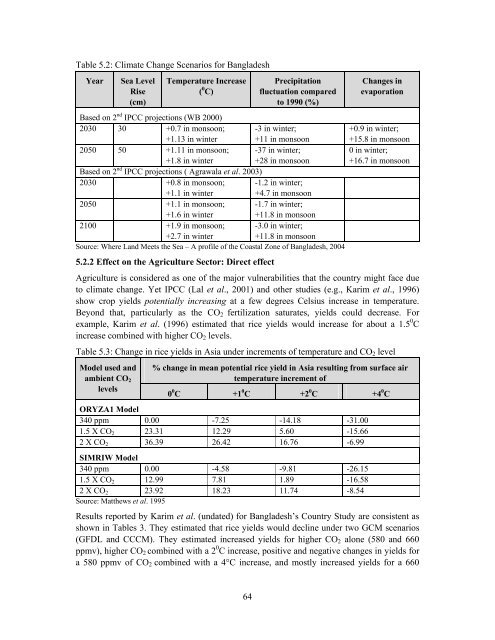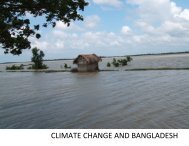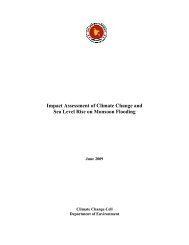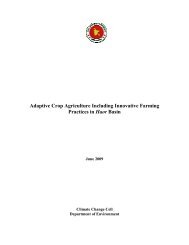Crop Insurance as a Risk Management Strategy in Bangladesh
Crop Insurance as a Risk Management Strategy in Bangladesh
Crop Insurance as a Risk Management Strategy in Bangladesh
Create successful ePaper yourself
Turn your PDF publications into a flip-book with our unique Google optimized e-Paper software.
Table 5.2: Climate Change Scenarios for <strong>Bangladesh</strong><br />
Year Sea Level<br />
Rise<br />
(cm)<br />
Temperature Incre<strong>as</strong>e<br />
( 0 C)<br />
64<br />
Precipitation<br />
fluctuation compared<br />
to 1990 (%)<br />
B<strong>as</strong>ed on 2 nd IPCC projections (WB 2000)<br />
2030 30 +0.7 <strong>in</strong> monsoon; -3 <strong>in</strong> w<strong>in</strong>ter;<br />
+1.13 <strong>in</strong> w<strong>in</strong>ter +11 <strong>in</strong> monsoon<br />
2050 50 +1.11 <strong>in</strong> monsoon; -37 <strong>in</strong> w<strong>in</strong>ter;<br />
+1.8 <strong>in</strong> w<strong>in</strong>ter +28 <strong>in</strong> monsoon<br />
B<strong>as</strong>ed on 2 nd IPCC projections ( Agrawala et al. 2003)<br />
2030 +0.8 <strong>in</strong> monsoon; -1.2 <strong>in</strong> w<strong>in</strong>ter;<br />
+1.1 <strong>in</strong> w<strong>in</strong>ter +4.7 <strong>in</strong> monsoon<br />
2050 +1.1 <strong>in</strong> monsoon; -1.7 <strong>in</strong> w<strong>in</strong>ter;<br />
+1.6 <strong>in</strong> w<strong>in</strong>ter +11.8 <strong>in</strong> monsoon<br />
2100 +1.9 <strong>in</strong> monsoon; -3.0 <strong>in</strong> w<strong>in</strong>ter;<br />
+2.7 <strong>in</strong> w<strong>in</strong>ter +11.8 <strong>in</strong> monsoon<br />
Source: Where Land Meets the Sea – A profile of the Co<strong>as</strong>tal Zone of <strong>Bangladesh</strong>, 2004<br />
5.2.2 Effect on the Agriculture Sector: Direct effect<br />
Changes <strong>in</strong><br />
evaporation<br />
+0.9 <strong>in</strong> w<strong>in</strong>ter;<br />
+15.8 <strong>in</strong> monsoon<br />
0 <strong>in</strong> w<strong>in</strong>ter;<br />
+16.7 <strong>in</strong> monsoon<br />
Agriculture is considered <strong>as</strong> one of the major vulnerabilities that the country might face due<br />
to climate change. Yet IPCC (Lal et al., 2001) and other studies (e.g., Karim et al., 1996)<br />
show crop yields potentially <strong>in</strong>cre<strong>as</strong><strong>in</strong>g at a few degrees Celsius <strong>in</strong>cre<strong>as</strong>e <strong>in</strong> temperature.<br />
Beyond that, particularly <strong>as</strong> the CO2 fertilization saturates, yields could decre<strong>as</strong>e. For<br />
example, Karim et al. (1996) estimated that rice yields would <strong>in</strong>cre<strong>as</strong>e for about a 1.5 0 C<br />
<strong>in</strong>cre<strong>as</strong>e comb<strong>in</strong>ed with higher CO2 levels.<br />
Table 5.3: Change <strong>in</strong> rice yields <strong>in</strong> Asia under <strong>in</strong>crements of temperature and CO2 level<br />
Model used and<br />
ambient CO2<br />
levels<br />
% change <strong>in</strong> mean potential rice yield <strong>in</strong> Asia result<strong>in</strong>g from surface air<br />
temperature <strong>in</strong>crement of<br />
0 0 C +1 0 C +2 0 C +4 0 C<br />
ORYZA1 Model<br />
340 ppm 0.00 -7.25 -14.18 -31.00<br />
1.5 X CO2 23.31 12.29 5.60 -15.66<br />
2 X CO2 36.39 26.42 16.76 -6.99<br />
SIMRIW Model<br />
340 ppm 0.00 -4.58 -9.81 -26.15<br />
1.5 X CO2 12.99 7.81 1.89 -16.58<br />
2 X CO2 23.92 18.23 11.74 -8.54<br />
Source: Matthews et al. 1995<br />
Results reported by Karim et al. (undated) for <strong>Bangladesh</strong>’s Country Study are consistent <strong>as</strong><br />
shown <strong>in</strong> Tables 3. They estimated that rice yields would decl<strong>in</strong>e under two GCM scenarios<br />
(GFDL and CCCM). They estimated <strong>in</strong>cre<strong>as</strong>ed yields for higher CO2 alone (580 and 660<br />
ppmv), higher CO2 comb<strong>in</strong>ed with a 2 0 C <strong>in</strong>cre<strong>as</strong>e, positive and negative changes <strong>in</strong> yields for<br />
a 580 ppmv of CO2 comb<strong>in</strong>ed with a 4°C <strong>in</strong>cre<strong>as</strong>e, and mostly <strong>in</strong>cre<strong>as</strong>ed yields for a 660





